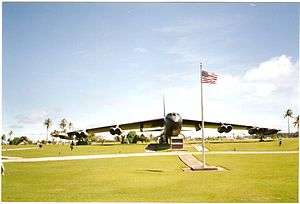Operation Arc Light

Operation Arc Light was the 1965 deployment of B-52F Stratofortresses as conventional bombers from bases in the US to Guam to support ground combat operations in Vietnam. By the middle of April 1966, all B-52Fs redeployed back to their bases in the US and were replaced by the Big Belly modified B-52D. Later in the war, the B-52G joined the B-52D.[1] By extension, Arc Light, and sometimes Arclight, is the code name and general term for the use of B-52D/F/G Stratofortress as a close air support (CAS) platform to support ground tactical operations assisted by ground-control-radar detachments of the 1st Combat Evaluation Group (1CEVG) in Operation Combat Skyspot during the Vietnam War. At the same time, investigations of secret CIA activities in Laos revealed that B-52s were used to systematically bomb Laos and Cambodia. In fact, the United States dropped more bombs on North Vietnamese Army-occupied eastern Laos than it did during World War II on Germany and Japan combined. To this day, large areas of Laos and Cambodia are still dangerous because of unexploded ordnance.
In 1964, the U.S. Air Force began to train strategic bomber crews in the delivery of conventional munitions, flying the B-52F. Under Project Big Belly, all B-52Ds were modified so that they could carry nearly 30 tons of conventional bombs. B-52s were deployed to Andersen air force base on the island of Guam, and U-Tapao Royal Thai Navy Airfield in Thailand. Arc Light operations were most often CAS bombing raids of enemy base camps, troops concentrations, and supply lines.
The first use of these heavy bombers in Southeast Asia occurred on 18 June 1965. Flying out of Andersen Air Force Base, Guam, twenty-seven aircraft used 750 and 1,000 pound bombs to attack a Viet Cong stronghold.[1] During this mission two B-52Fs were lost in a mid-air collision; another was unable to conduct air refueling. Missions were commonly flown in three-plane formations known as "cells" and were also employed when ground units in heavy combat requested fire support. Releasing their bombs from high in the stratosphere, the B-52s could neither be seen nor heard from the ground. B-52s were instrumental in nearly wiping out enemy concentrations besieging Khe Sanh in 1968[1] and An Loc and Kontum in 1972.

Arc Light was re-activated on Andersen on February 8, 1972 when President Richard Nixon resumed bombing of North Vietnam in an effort to move peace talks along. Over 15,000 men were sent to Andersen on temporary duty over the next 90 days. With limited barracks and other facilities tents were set up behind for use by men working 80-hour weeks.
Arc Light missions continued until the cessation of hostilities by all U.S. forces on August 15, 1973. Between June 1965 and August 1973, 126,615 B-52D/F/G sorties were flown over Southeast Asia. During those operations, the U.S. Air Force lost 31 B-52s, 18 from hostile fire over North Vietnam and 13 from operational causes.
The typical full bomb loads were: B-52F, 36 500 lb. and 750 lb. bombs in a mixed load, or 51 500 lb. bombs, 27 in the bomb bay and 24 on underwing pylons. B-52D, 108 500 lb. bombs, or a mixed load of 64 500 lb. bombs in the bomb bay and 24 750 lb. bombs on underwing pylons. B-52G, 27 bombs, all in the bomb bay, no external bombs were carried.
Combat Skyspot Memorial
Nineteen technicians of the 1st Combat Evaluation Group (1CEVG) were lost in ground combat.[2] On September 21, 2010, President Barack Obama presented the Medal of Honor to the sons of Chief Master Sergeant Richard L. Etchberger for his actions in the battle of Lima Site 85. A memorial to all 1CEVG technicians is located directly behind the Arc Light memorial.[3]
In popular culture
- There is a brief reference to 'Operation Arc Light' in the film Apocalypse Now by the character "Captain Willard", played by Martin Sheen. As the river boat (PBR) carrying Willard is moving up the coast to rendezvous with the air cavalry escort, they hear the rumble of a B-52 strike in the distance. When the character "Chef" asks what's going on, Willard replies, "Arc Light, B-52 strike." The character "Mr. Clean" explains Arc Light: "Charlie don't never see 'em or hear 'em, but it'll suck the air out of your damn lungs."
- The phrase was used as the title of Eric L. Harry's military techno-thriller, Arc Light.
- In the video game Men of Valor, while at a besieged Khe Sanh, Dean and Hoss are informed that Dean's brother Jamie's squad is being overrun by NVA regulars and that they just called in an Arc Light on their own position. Later, after safely returning to Khe Sanh, the Marines witness a B-52 strike up close.
- In the video game Call of Duty: Black Ops, an Arc Light strike occurs on the NVA troops at the end of the level "S.O.G."
References
- 1 2 3 Operation ArcLight from The Air Force Historical Studies Office (AFHSO). Archived November 9, 2005, at the Wayback Machine.
- ↑ 1CEVG member. "Combat SkySpot". unit history. Tripod. Retrieved 26 July 2011.
- ↑ member. "The COMBAT SKYSPOT memorial at Andersen AFB Guam, September, 1999". unit history. limasite85.us. Retrieved 23 Sep 2010.
The memorial consists of an AN/MSQ-77 (AN/TSQ-81) parabolic antenna poised at 45 degrees elevation... situated directly behind the ARC LIGHT Memorial, a B52D Stratofortress ... The aircraft and the radar are facing the Vietnam theater, in solemn tribute to the men who flew the weapons and the men who directed them over targets of opportunity.